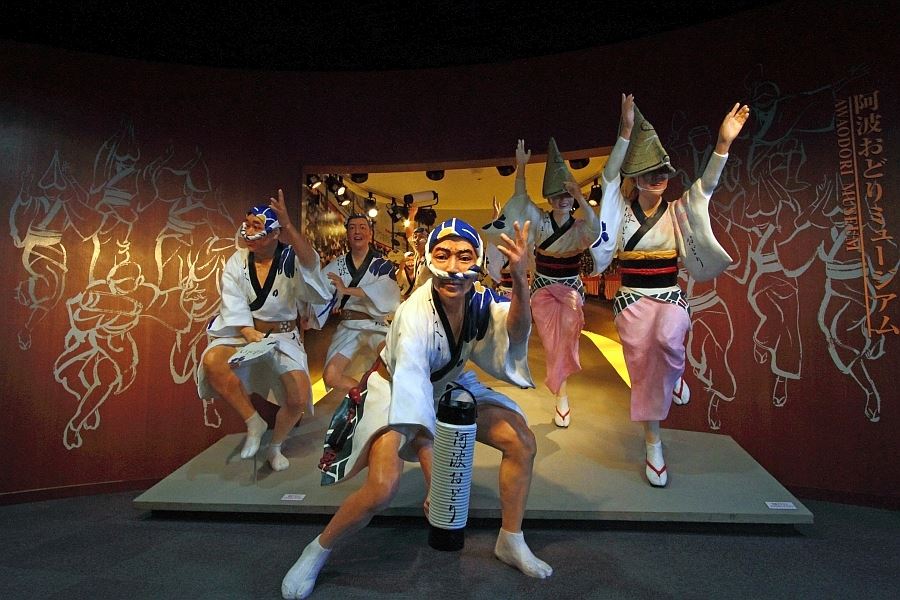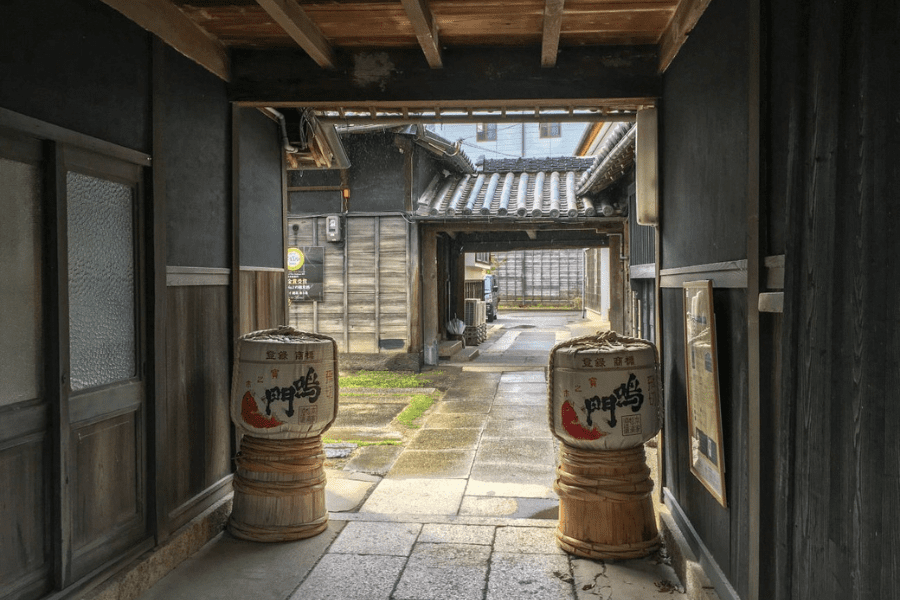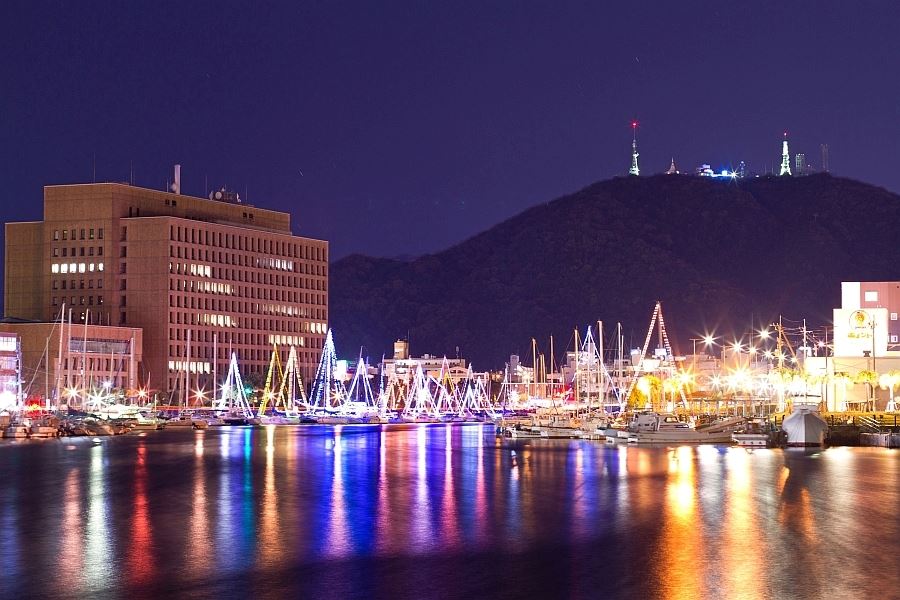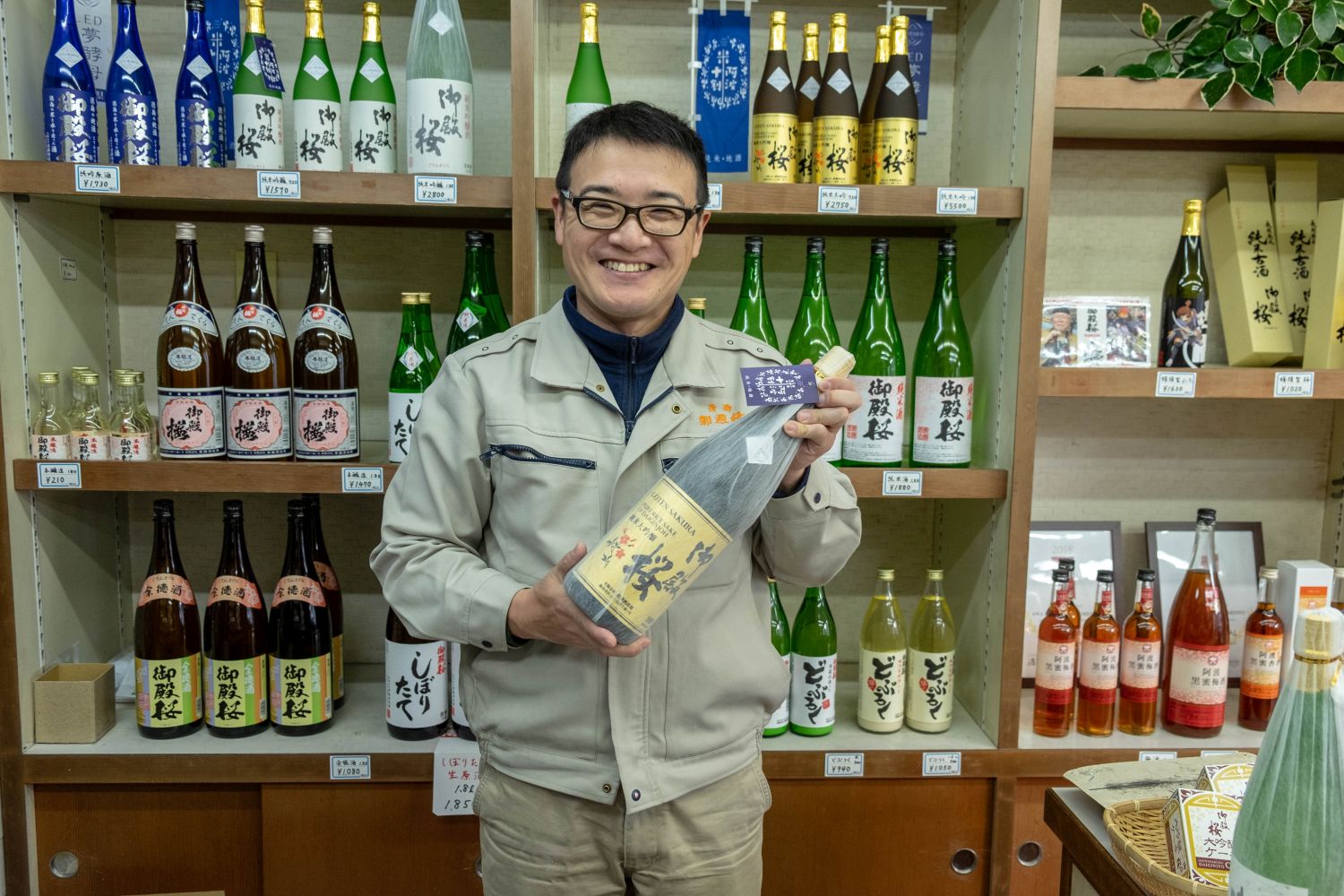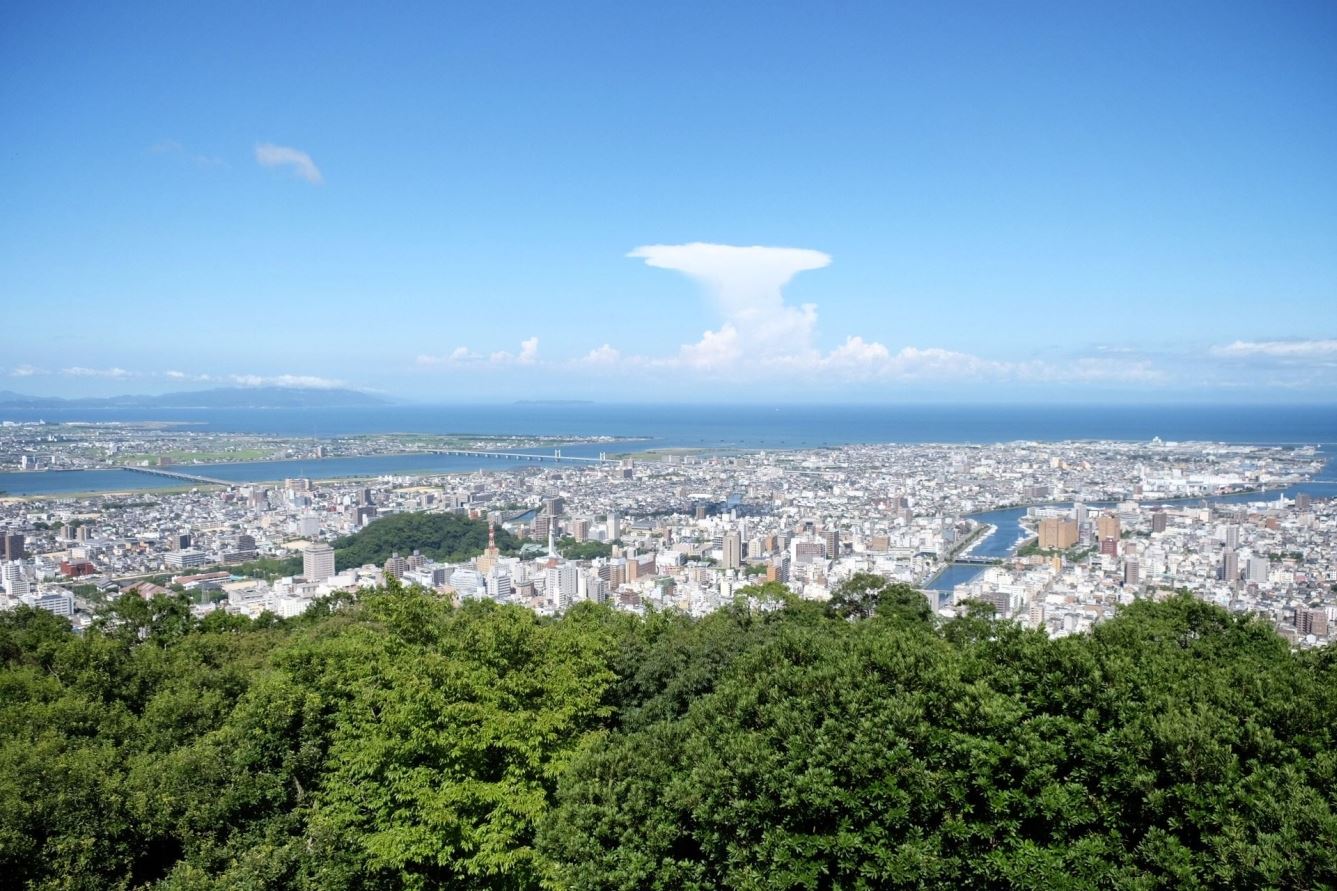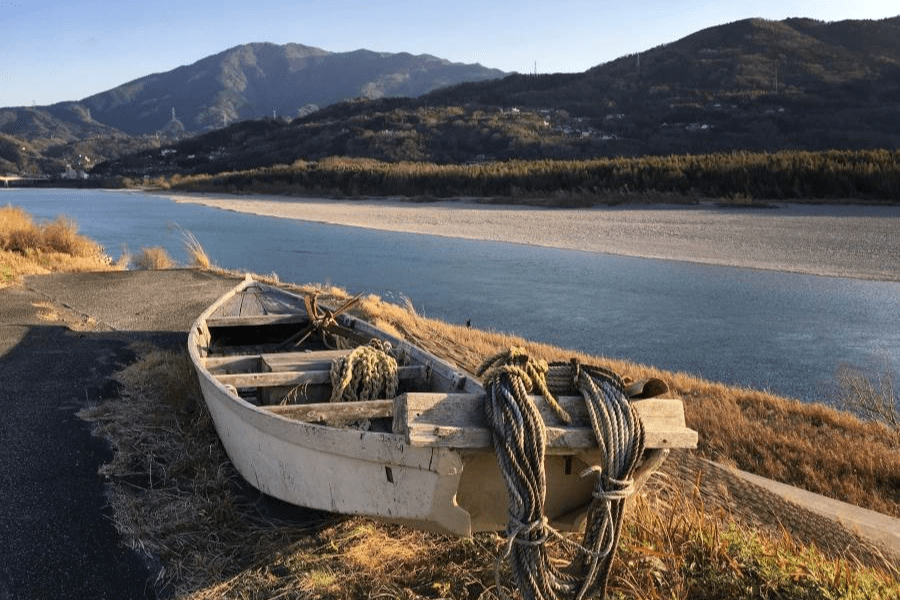Nisshin Shurui Brewery
Home » Nisshin Shurui Brewery
Nisshin Shurui Brewery
Nisshin Shurui is a diversified alcoholic beverage producer located in Itano, a farming town next to the Yoshino river, between the cities of Awa and Tokushima. The Head Office and separate brewery and distillery facility lie along the route travelled by pilgrims walking the Shikoku Pilgrimage.
Shikoku Sake visited the brewery and distillery in February at the height of the brewing season. We met with company president Maeda Yasuhito, director of production Tomiyama Akihiro, and brewer Tanabe Yoshihiro for a tour of the facility and to ask our usual questions. Not all sake brewers are equally articulate, but it was a joy to hear the carefully considered responses from the team.
Interview
When was the brewery established?
Tanabe-san: “Ansei 4 (Laughs, because really, who understands Japanese dates?). That’s 1857, towards the end of the Edo period. The buildings that we’re in were built in 1998 and our oldest building here is about 50 years old.”
Maeda-san: “I’m the 7th generation of the Maeda family who started the brewery.”
How many people are on the brewing team?
Tomiyama-san: “Seven, including me. Instead of a tōji, we have a director of production”.
What rice do you use?
Maeda-san: “We try to use locally grown produce as far as possible, for example Yamadanishiki rice from Awa city and sweet potatoes grown in Tokushima. Awa Yamadanishiki differs slightly from its parent from Hyōgo by having a bigger seed head, and also it’s easier to make kōji rice with it. And kōji rice is the key to making good sake. We’ve also started using Gin no Sato rice for a tiny fraction of our line-up.”
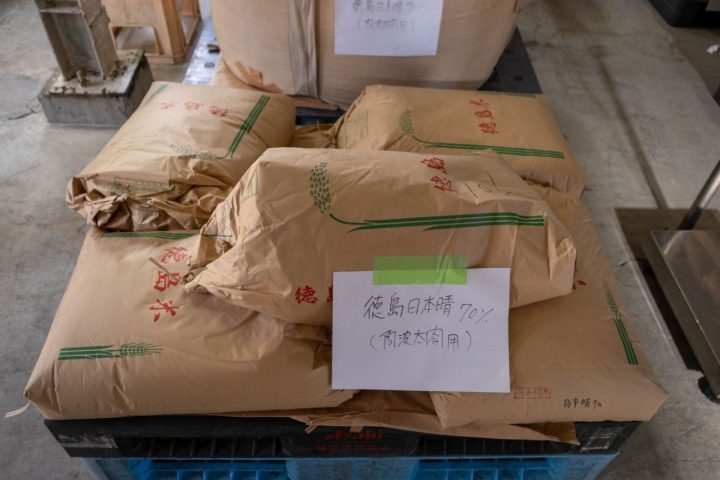
What is your water source?
Maeda-san: “We use purified water, but its source is the Yoshino River. We stopped using well water some time ago.”
What yeast do you use?
Tomiyama-san: “We use LED Yume Kōbo which was developed by scientists from Tokushima, and Kyōkai Kōbo 1801.”
What is the defining character of your sake?
Maeda-san: “Unlike many other brewers, we have a very diverse product range. We started out as Maeda Shuzō making sake, and Nisshin Shurui making beverages other than sake, such as umeshu. The two companies merged in 1968, and today we make sake, and shōchū, including potato and sudachi varieties, as well as gin. About 60% of our output is sake, with 40% for other drinks.
Also, this facility is only for brewing and distilling – bottling is done at our separate Head Office – so we don’t really have the atmosphere of a traditional sake brewery. We used to have an old brewery in Tokushima city until about twelve years ago, but then we moved out here.”
Tomiyama-san: “Regarding sake in particular, Awa city is a major producer of Yamadanishiki, the most popular brewing rice. We’re the only brewer in this immediate area and we take a direct interest in how the rice is grown, visiting farmers during planting, harvesting and so on. Awa Yamadanishiki produces a rich, expansive sake, and that’s what we aim for.
What is the defining character of Tokushima sake?
Tomiyama-san: “Japanese people tend not to think of Tokushima as a sake-brewing region. Within Shikoku, Kōchi is much better known as a sake producer, and their sake is generally considered to be dry. But in Tokushima, there’s a wide variety of profiles. Each brewery has its own unique flavour, based on its own personality.
From the point of view of sake nationwide, where is your sake positioned?
Maeda-san: “The food eaten in the east and west of Tokushima is completely different, and as a Tokushima brewer, we aim to make sake that complements any food. So our sake is prized for its reliable high quality and the ability to pair it with many types of food. It may be an odd way to put it, but we don’t make many mistakes.”
Which countries are you currently exporting your sake to?
Maeda-san: “We export some sake to Hong Kong, China, and Italy, but in fact we export more of our other products like sudachi-chū, to America and so on.
What are your thoughts about overseas drinkers of your sake?
Tomiyama-san: “With the boom in inbound tourism, a lot of people from overseas are visiting sake breweries. You see it on the news and magazines all the time. But apart from people walking the Shikoku Pilgrimage, we’re not in an area where foreign tourists visit. We have all of our products on display at the Head Office, and we’d be happy if people dropped in and tried them.”
Is there a particular product that you’d like overseas drinkers to try?
Tomiyama-san: “This is Sakura Bijin sake. It’s daiginjō genshu made with Yamadanishiki rice polished to 50%. A quantity of alcohol is added to daiginjō to bring out the aroma, but instead of the usual flavourless brewer’s alcohol, in this case, we used aromatic rice shōchū. The sake is matured in casks made of cherry wood, which also imparts a subtle flavour. We’ve also put a lot of effort into the design of the bottle and label. This is perfect for enjoying under the cherry blossom in April.
This is Kodō, an 80% polished junmaishu sake with a difference. We used white kōji normally used for shōchū instead of the yellow kōji used for sake. It produces citric acid resulting in a sake with a considerable punch. People who enjoy warm sake can wax very enthusiastic about this one. Yakitori chicken is one of the signature foods of Tokushima, and this makes a very good match.
This is Sato Musume, made with the highest grade of Tokushima’s branded sweet potato, Naruto Kintoki. It has a very mild and gentle aroma and taste.
We also make gin using the rice alcohol we saw earlier as the base. It’s called Awa Gin and the botanicals are specific to Tokushima – sudachi, yuzu, sanshō, and bancha fermented tea. There are two types, one with juniper berries, and one without.”
Maeda-san: “The combination of rice-based alcohol with its own kōji character and the locally produced botanicals gives this gin a unique, robust, and very distinctive flavour.”
Is there a restaurant near here where people can drink your sake?
Tomiyama-san: “Maybe an udon restaurant or two …?”
Maeda-san: “This is basically a farming area without the population to support many restaurants. But if you go into Tokushima city, our sake is served in many izakaya and fine Japanese restaurants.”
Do any of your staff speak a foreign language?
Laughter. Maeda-san: “There is someone in the Head Office who can just about speak some English, but since we get so very few visitors, there isn’t a pressing need.”
Brewery visit
Tomiyama-san took us for a tour of the facilities. First, we saw the storeroom where the polished rice is stored. Nisshin has its riced polished by a contractor, and there were bags of Yamadanishiki polished to 70% or 50%, and Nihonbare for distilling.
Next, we visited the brewing area. We’ve never seen such a tidy brewery. On the second floor, there’s variously sized equipment for washing the rice according to the size of the batch being produced, including a little Woodson washer for the premium grades. Similarly there are vessels for soaking large and small batches. Most of the second floor is taken up by a huge continuous rice steamer and cooling machine, something of a rarity in Shikoku, although they do have a traditional koshiki steamer for smaller batches.
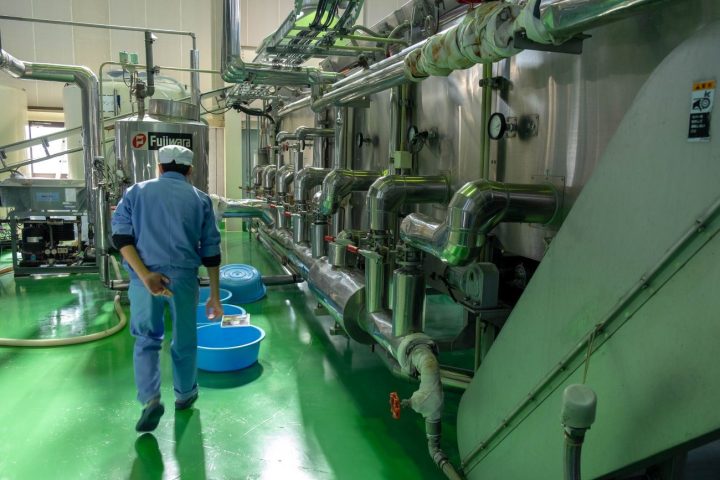
We had a look at the kōji room where the kōji rice is made in boxes that hold about 15 kg of rice.
On that day, they were making ginjō, and a worker was checking the temperature of steamed rice before adding it to the mash in a special temperature-controlled room used exclusively for making the higher grades.
For pressing most of the sake, a large NSK accordion press is used, but a fune type is used for the special grades.
On the way to see the distillery, we passed a tank where a rice mash is being prepared for distilling into shōchū, and very large tanks for maturing the sake. There’s an atmospheric distillation still for potato shōchū and a vacuum distillation still for rice and other types. The distilled shōchū is matured in tanks onsite, and then trucked to the Head Office for bottling.
The visit ended with a tasting. It was a delight to try the varied and high-quality products we’d just heard about.
Information
Name in Japanese: 日新酒類
Pronunciation: nisshin shurui
Address: 283 Kamirokujo, Kamiita, Itano District, Tokushima 771-1345
Opening hours: 9:00-17:00
Website: http://www.nissin-shurui.co.jp/
Related Tours

Experience the most beautiful and interesting temples of the Shikoku Pilgrimage in seven days.

A tour for families or friends, staying in the most characterful kominka and ryokan of Shikoku.

Visit the most beautiful and interesting temples of the Shikoku Pilgrimage and walk the toughest trails.

